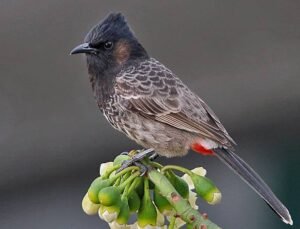Introduction to Common Cat Snakes
Common Cat Snake All Information, scientifically known as Boiga trigonata, is a unique and fascinating species that often captures the interest of snake enthusiasts and researchers. It is known for its slender build, large head, and distinctively vertical, cat-like pupils—attributes that contribute to its common name. These snakes are primarily found in South Asia, including India, Pakistan, and Sri Lanka, where they thrive in various habitats ranging from dry forests to urban areas. Despite being mildly venomous, the Common Cat Snake poses minimal threat to humans, making it an intriguing species for both amateurs and professional herpetologists. The species plays a vital role in maintaining ecological balance by controlling rodent and small bird populations.
| Category | Details |
|---|---|
| Snake Name | Common Cat Snake |
| Scientific Name | Boiga trigonata |
| Wild Life Protection Act (WLPA) Schedule | Schedule IV (India) |
| Regional Names | – Marathi: मांजऱ्या – Tamil: புனை பாம்பு (Punai Paambu) – Telugu: పిల్లి పాము (Pilli Pamu) – Kannada: ಬೆಕ್ಕಿನ ಹಾವು (Bekkina Haavu) – Malayalam: പൂച്ച പാമ്പ് (Poocha Paambu) – Bengali: বিড়াল সাপ (Biral Shaap) – Gujarati: બિલાડી સાપ (Biladi Saap) – Punjabi: ਬਿੱਲੀ ਸਾਪ (Billi Saap) – Odia: ବିଲାଡ଼ି ସାପ (Biladi Saapa) |
| Physical Description | Slender body, large head, vertical pupils, grey or brown color with darker patterns along the body. |
| Habitat | Found in dry forests, scrublands, farmlands, and urban areas. |
| Diet | Feeds on lizards, small birds, and rodents. |
| Behavior | Nocturnal, arboreal, and mildly aggressive when threatened. |
| Venomous or Non-Venomous | Mildly venomous |
| Venom Type | Mild neurotoxic |
| Venom Effects on Prey | Causes paralysis, enabling easy capture of small prey. |
| Venom Effects on Humans | Minor symptoms like swelling, pain, and itching; rarely severe reactions. |
| Common or Rare Species | Common species |
| Life Span | Up to 12 years in the wild |
| Mating & Reproduction | Mating season in early summer; lays 4-12 eggs in concealed locations. |

General Characteristics and Anatomy
Common Cat Snakes have an elongated body with smooth scales that allow them to glide effortlessly through their habitats. They possess large, bulging eyes with vertical slits for pupils, giving them a “cat-like” appearance. Their coloration varies from gray to brown, with dark blotches along the body that offer excellent camouflage among leaves and tree bark. Despite their intimidating look, these snakes are relatively small, reaching lengths of around 1.5 to 2 meters. Their anatomy is designed for climbing, with strong muscles and flexible jaws that allow them to feed on a wide range of prey.
Role of Snakes in the Ecosystem
Snakes like the Common Cat Snake play an essential role in maintaining the balance of ecosystems. As predators, they help control populations of various small animals, particularly rodents, which can become pests if left unchecked. This predatory role is crucial in agriculture, where rodents can damage crops. Additionally, snakes are prey for larger predators, contributing to the food web. Snakes also facilitate seed dispersal through the digestion of fruits consumed by their prey, further enriching the ecosystem.
Common Myths and Misconceptions
Many myths surround the Common Cat Snake. One common misconception is that all snakes with cat-like eyes are highly venomous, which is not true in this case. The Common Cat Snake is only mildly venomous to humans, and its venom is designed more for subduing small prey rather than posing a significant threat to larger animals or humans.
Habitat and Distribution
Snakes like the Common Cat Snake can be found in diverse habitats such as forests, deserts, wetlands, and even urban areas. They are highly adaptable creatures, with each species having specific preferences. For example, forest snakes often thrive in dense vegetation, while those in deserts have adaptations to survive in extreme temperatures and scarce water conditions.
The Common Cat Snake primarily inhabits dry forests, scrublands, farmlands, and even suburban areas, especially where there is an abundance of small prey. Geographically, this species is found throughout South Asia, including India, Pakistan, Sri Lanka, and Nepal.
| Habitat | Details |
|---|---|
| Forests | Home to many species; provides cover and prey like birds, rodents, and lizards. |
| Deserts | Fewer species; snakes have adaptations like burrowing to escape heat and find food. |
| Wetlands | Snakes in these areas often prey on amphibians, fish, and small aquatic animals. |
| Urban Areas | Species like the Common Cat Snake adapt to human presence, feeding on rodents and small birds. |
| Geographical Distribution | Found throughout South Asia, including India, Pakistan, Sri Lanka, and Nepal. |
Snake Behavior
Hunting and Feeding Habits
The Common Cat Snake is primarily nocturnal, meaning it hunts during the night. It has keen vision adapted to low light, aiding in the detection of small prey such as lizards, birds, and rodents. Its mildly venomous bite helps subdue prey, which is swallowed whole using flexible jaws. The snake is an ambush predator, relying on stealth and patience rather than speed or brute force.
Mating and Reproduction
The mating season for the Common Cat Snake typically begins in early summer. After successful mating, females lay between 4 to 12 eggs in secluded, safe environments such as leaf litter or burrows. The eggs incubate for about two months before hatching. Juvenile snakes are independent from birth, capable of hunting and fending for themselves.
Defense Mechanisms
When threatened, the Common Cat Snake may use several defense strategies, including flattening its body to appear larger or releasing a foul-smelling musk to deter predators. Its mild venom can also act as a deterrent, though it is primarily effective against small prey rather than large predators or humans.
First Aid and Medical Treatment for Snake Bites
First Aid and Medical Treatment for Common Cat Snake Bites
- Remain Calm and Assess the Situation: Most Common Cat Snake bites are not life-threatening. Try to stay calm to avoid spreading the venom quickly through the bloodstream.
- Ensure Safety: Move away from the snake to avoid a second bite.
- Identify the Snake (If Possible): Knowing it is a Common Cat Snake can help medical professionals provide appropriate care.
- Contact Professional Help: Seek medical assistance immediately, even if symptoms seem mild.
- Prevent Future Encounters: Learn to recognize snake habitats and behaviors to minimize risks.
Global Impact of Common Cat Snake Bites
While the Common Cat Snake’s venom is typically mild for humans, it has a more potent effect on its prey, such as small birds and rodents. Globally, the impact of bites from this species on humans is minimal, with very few cases of severe reactions. The primary concern remains localized symptoms like pain, swelling, and itching.
If You Encounter a Snake on Your Property
- Remain Calm and Assess the Situation: Most snakes, including the Common Cat Snake, are non-aggressive and will move away if not threatened.
- Ensure Safety: Keep a safe distance from the snake and ensure pets and children are secure.
- Identify the Snake (If Possible): Knowing the type can help determine if there’s any danger.
- Contact Professional Help: If the snake poses a threat, call local wildlife control or a professional snake catcher.
- Prevent Future Encounters: Seal cracks, trim vegetation, and remove food sources to make your property less appealing to snakes.
- Educate Yourself and Others: Learn more about local snake species to understand their behavior and reduce fear.
Tips for Snake Enthusiasts
- How to Safely Observe Snakes in the Wild: Keep a respectful distance, avoid sudden movements, and use binoculars for a closer look.
- Tips for Aspiring Herpetologists: Learn about local species, join a herpetology group, and engage in citizen science projects to deepen your knowledge.
Some Interesting Facts about the Common Cat Snake
- Unique Eye Structure: The Common Cat Snake’s vertical pupils are an adaptation that helps it see well in low-light conditions, making it a proficient night hunter.
- Flexible Jaws: Their highly flexible jaws enable them to consume prey much larger than their head, a fascinating trait among many snakes.
- Non-Threatening to Humans: Despite being venomous, their venom is mild and rarely causes severe reactions in humans, contributing to their relatively benign reputation.
- Arboreal Adaptations: They are excellent climbers, often found in trees or shrubs, which aids them in hunting small birds and rodents.
- Mimicry Behavior: When threatened, they often mimic the posture of more dangerous snakes to deter predators, despite their mild venom.
This comprehensive information provides a well-rounded view of the Common Cat Snake, catering to enthusiasts and the general public interested in learning more about this fascinating species. For more details, visit WildlifeNest.com.
FAQs About the Common Cat Snake
1. What is the scientific name of the Common Cat Snake?
The scientific name of the Common Cat Snake is Boiga trigonata. This species is known for its unique appearance, particularly its large, cat-like eyes, which give it its name.
2. Are Common Cat Snakes venomous?
Yes, the Common Cat Snake is mildly venomous. Its venom primarily affects small prey like lizards and birds, causing paralysis. For humans, the venom is not considered highly dangerous, but a bite may cause localized pain, swelling, or mild reactions.
3. Where can the Common Cat Snake be found?
The Common Cat Snake is widely distributed across South Asia, particularly in countries like India, Pakistan, Nepal, and Sri Lanka. It thrives in various habitats, including forests, shrublands, grasslands, and sometimes near human settlements.
4. What do Common Cat Snakes eat?
Common Cat Snakes are carnivorous and primarily feed on small reptiles, birds, and occasionally small mammals. They are nocturnal hunters and use their excellent climbing skills to catch prey.
5. How long do Common Cat Snakes live?
In the wild, Common Cat Snakes have a lifespan of around 10-12 years, depending on environmental conditions and predation. In captivity, with proper care, they can live slightly longer.
6. What are the regional names of the Common Cat Snake in India?
The Common Cat Snake is known by various names across India:
- Marathi: वाघमारे साप (Waghmare Saap)
- Hindi: बिल्ली साँप (Billi Saap)
- Tamil: புனை பாம்பு (Punai Paambu)
- Telugu: పిల్లి పాము (Pilli Pamu)
- Kannada: ಬೆಕ್ಕಿನ ಹಾವು (Bekkina Haavu)
- Malayalam: പൂച്ച പാമ്പ് (Poocha Paambu)
- Bengali: বিড়াল সাপ (Biral Shaap)
- Gujarati: બિલાડી સાપ (Biladi Saap)
- Punjabi: ਬਿੱਲੀ ਸਾਪ (Billi Saap)
- Odia: ବିଲାଡ଼ି ସାପ (Biladi Saapa)
7. How do Common Cat Snakes behave in the wild?
Common Cat Snakes are generally shy and avoid human contact. They are nocturnal and arboreal, meaning they are active at night and often found in trees. They rely on their camouflage to blend into their surroundings and avoid predators.
8. What should I do if I encounter a Common Cat Snake?
If you encounter a Common Cat Snake, remain calm and avoid sudden movements. Do not attempt to handle or provoke the snake. Keep a safe distance, observe it from afar, and contact a local wildlife professional if necessary.
9. Can Common Cat Snakes be kept as pets?
While it is possible to keep Common Cat Snakes as pets, they require specialized care and an appropriate environment to thrive. It’s essential to check local regulations and consult with a herpetologist or experienced reptile keeper before considering them as pets.
10. What should I do if I get bitten by a Common Cat Snake?
If bitten by a Common Cat Snake, stay calm and seek medical attention immediately. The venom is not highly toxic to humans, but it can cause discomfort, swelling, or allergic reactions. Applying first aid, such as cleaning the wound and keeping the affected limb still, can help manage the bite until professional help arrives.
Recent Posts
| Topic | Link |
|---|---|
| Banded Krait Snake | Discover detailed insights into the Banded Krait Snake, including its habitat, behavior, and unique features. Read more |
| King Cobra | Dive into the world of the King Cobra and learn about its impressive size, venom, and role in the ecosystem. Explore here |
| Saw-Scaled Viper Snake | Uncover the facts about the Saw-Scaled Viper Snake, its characteristics, and its significance in the reptile world. Learn more |
| Common Krait | Get to know the Common Krait, its habitat, behavior, and what makes it unique among other snakes. Check it out |
| Russell’s Viper | Explore detailed information about Russell’s Viper, including its venom, habitat, and how it fits into the snake family. Find out more |
| Cobra Snake | Learn all about Cobra Snakes, their various types, and fascinating facts about their behavior and venom. Discover here |
| The Big Four Snakes of India | An overview of the Big Four Snakes of India, their identification, and important details about each one. Read more |
| What Are Reptiles? | A comprehensive guide to understanding reptiles, their characteristics, and their role in nature. Learn more |
| World Wildlife Day | Celebrate World Wildlife Day with information about its significance and how you can get involved. Explore here |


